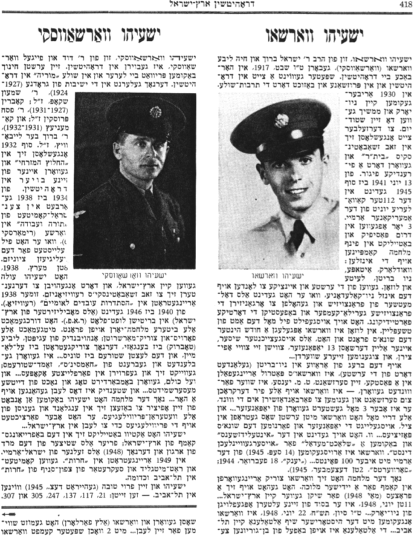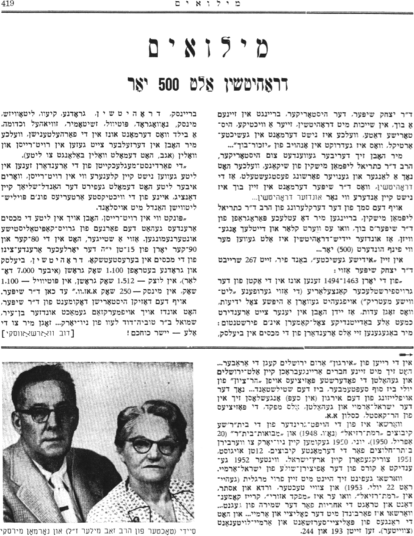
[Page 418]
Yeshayahu Warshaw [Page 419]
Yeshayahu Warshaw, a son of Rabbi Yisrael Baruch and Chaya Liba Warshaw (Warshavsky) was born on 15 Shvat [7 February] 1917 in Horbacha near Drohitchin. He later lived for a while in Drohitchin and in Pruzhany, where he attended the Tarbut school. In 1930 he moved to New York and continued his studies. At the same time Yeshayahu join Ze'ev Jabotinsky's Betar movement, where he became a leading figure. From June 13, 1941 to the end of 1945, he served in the 112th cavalry unit of the US army. He spent three years in the South Pacific, and participated in five military campaigns on the islands of Woodlark, Itape, New Britain, Lyete and Luzon. Warshaw was one of the first and only men to land on the island of New Caledonia, where he served as a French interpreter, and helped organize the French guerrilla forces and strengthen the defenses there. He also served many times as chaplain. In Luzon Warshaw spent a month behind enemy lines, and as an outstanding shooter, shot thirteen Japanese soldiers himself; among them were two officers, and he captured their swords.
On the beach of Arawa in New Britain (where he was one of the first to land), Warshaw's patrol was ambushed. His sergeant, T. M. Yensa, was badly injured, and Warshaw crawled on all fours to the sergeant to bandage his wounds. The Japanese shot him at three times, and every time he was able to shoot back and hit the target. He killed the Japanese and took the enemy's positions. Warshaw also served in the intelligence services, and was discharged on September 14, 1945 with more than 100 points (Yank, February 18, 1944; Forverts, December 2, 1945).
After the war Warshaw returned to join the battle for a Jewish state. He was taken to court in May, 1948 for having sent arms to Palestine, and on June 11, 1948 without telling his parents, he secretly left New York. On June 22, 1948 he arrived on the historic ship Altalena in Tel Aviv. On Ben Gurion's orders this ship was shot, and Warshaw had to swim away to save his life. Two weeks later he joined the ranks of the [continues on lower half of p. 419] Irgun against the Arabs around Jerusalem. He and his friends got into the Old City and held the forward positions on Mount Zion from July to September, until the ceasefire. After leaving the organization in September, Warshaw joined the Israeli army as an officer and held the positions at Kastel Mountain, Kaslon, etc.
Warshaw was one of the main founders of the Betar kibbutzim, Ramat Raziel (November 1948) and Mevuot Betar (April 20, 1950). In June 1950 he came to New York to recruit Betar pioneers for those kibbutzim. On August 12, 1951 he returned to Israel, and in the winter of 1952 he completed a commander's course in the Israeli army.
Warshaw [today] lives with his wife Margalit (married on July 22, 1953) and two daughters, Varda and Esther in Ramat Raziel, where he is a regional commander and is responsible for protecting the area. Warshaw is connected with the army and the police, and has the ranks of police sergeant and army lieutenant (second). See pp. 193 and 244.
Yeshayahu Warshavsky
[photo:] Yeshayahu Warshavsky
Yeshayahu Warshavsky, a son of R. David and Feigel Warshavsky, was born in Drohitchin. He received his early education under private tutors and in the Moriah School in Drohitchin. Afterwards he studied in yeshivas in Grodno (1924-1927) under Rabbi Shimon Shkop; in Kobrin (1927-1931) under Rabbi Pesach Pruskin, and in Kaminetz (1931-1933) under Rabbi Baruch Ber Leibovitz. At the end of 1932 he joined the Hechalutz Hamizrachi [Religious Zionist Pioneers] and became one of the people who developed the organization in Drohitchin. From 1934 to 1938 he worked in the central committee of the Torah Ve-Avoda [Torah and Labor] organization in Warsaw (at 6 Rimarski St.), where he worked a great deal on behalf of religious Zionism. On March 8, 1938, Yeshayahu moved to Palestine, where he became affiliated with Ze'ev Jabotinsky's revisionist movement. In the summer of 1938 he joined their Nationalist Labor Federation.
From 1940 to 1946, Warshavsky served as a conscripted soldier from Palestine with the British air force (RAF), and spent all the bitter war years at the battlefront. He traversed all the routes, starting from Egypt, Libya (Tobruk), all the way to Benghazi, and then back via Al-Lamein and the last assault up to Tunis. He was blinded and burned from the hamseen sandstorms, and soaked and frozen in flooded trenches; worst of all, he lived through days and nights of bombardments from German Messerschmidts, and had his life hanging by a hair. After the war, Yeshayahu received an offer from his officer to settle in England and benefit from all veteran privileges. However, he passed on the privileges so he could live in Israel.
Yeshayahu was active in the War of Independence in Israel, and had participated earlier in the uprising of the Irgun. Finally, he became a soldier in the Israeli army. In 1949 he joined the Herut party, and became a committee member and secretary of the northern branch of Herut in Tel Aviv.
Yeshayahu and his wife Tova (married December 1945) [live] in Tel Aviv. See pp. 21, 117, 137, 247, 305 and 307.

JewishGen, Inc. makes no representations regarding the accuracy of
the translation. The reader may wish to refer to the original material
for verification.
JewishGen is not responsible for inaccuracies or omissions in the original work and cannot rewrite or edit the text to correct inaccuracies and/or omissions.
Our mission is to produce a translation of the original work and we cannot verify the accuracy of statements or alter facts cited.
 Drogichin, Belarus
Drogichin, Belarus
 Yizkor Book Project
Yizkor Book Project
 JewishGen Home Page
JewishGen Home Page
Copyright © 1999-2025 by JewishGen, Inc.
Updated 6 Dec 2001 by LA